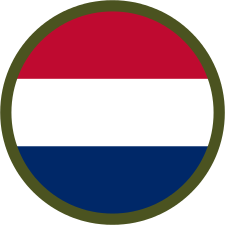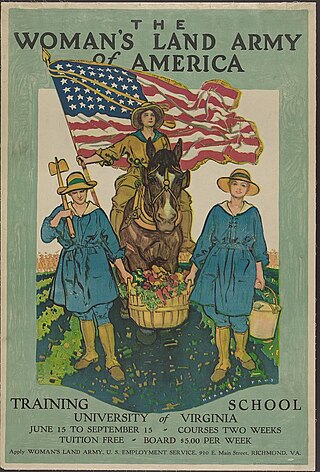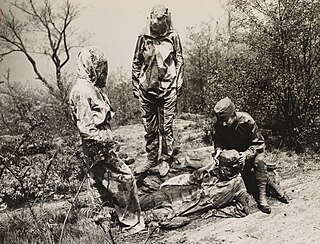
Crystal Catherine Eastman was an American lawyer, antimilitarist, feminist, socialist, and journalist. She was a leader in the fight for women's suffrage, a co-founder and co-editor with her brother Max Eastman of the radical arts and politics magazine The Liberator, co-founder of the Women's International League for Peace and Freedom, and co-founder in 1920 of the American Civil Liberties Union. In 2000, she was inducted into the National Women's Hall of Fame in Seneca Falls, New York.

The American Expeditionary Forces (AEF) was a formation of the United States Armed Forces on the Western Front during World War I, comprised mostly of units from the U.S. Army. The AEF was established on July 5, 1917, in France under the command of then-Major General John J. Pershing. It fought alongside French Army, British Army, Canadian Army, British Indian Army, New Zealand Army and Australian Army units against the Imperial German Army. A small number of AEF troops also fought alongside Italian Army units in 1918 against the Austro-Hungarian Army. The AEF helped the French Army on the Western Front during the Aisne Offensive in the summer of 1918, and fought its major actions in the Battle of Saint-Mihiel and the Meuse-Argonne Offensive in the latter part of 1918.

Women have been serving in the military since the inception of organized warfare, in both combat and non-combat roles. Their inclusion in combat missions has increased in recent decades, often serving as pilots, mechanics, and infantry officers.

Women in World War I were mobilized in unprecedented numbers on all sides. The vast majority of these women were drafted into the civilian work force to replace conscripted men or to work in greatly expanded munitions factories. Thousands served in the military in support roles, and in some countries many saw combat as well.

The Council of National Defense was a United States organization formed during World War I to coordinate resources and industry in support of the war effort, including the coordination of transportation, industrial and farm production, financial support for the war, and public morale.

The Woman's Relief Corps (WRC) is a charitable organization in the United States, originally founded as the official women's auxiliary to the Grand Army of the Republic (GAR) in 1883. The organization was designed to assist the GAR and provide post-war relief to Union veterans. The GAR had been created as a "fraternal" organization and refused to allow women to join up until the creation of this auxiliary. It is largely dedicated to historical preservation of research and official documentation related to the WRC and GAR.

The United States declared war on the German Empire on April 6, 1917, nearly three years after World War I started. A ceasefire and armistice were declared on November 11, 1918. Before entering the war, the U.S. had remained neutral, though it had been an important supplier to the United Kingdom, France, and the other powers of the Allies of World War I.

Hello Girls was the colloquial name for American female switchboard operators in World War I, formally known as the Signal Corps Female Telephone Operators Unit. During World War I, these switchboard operators were sworn into the U.S. Army Signal Corps. Until 1977 they were officially categorized as civilian "contract employees" of the US Army.

The Woman's Land Army of America (WLAA), later the Woman's Land Army (WLA), was a civilian organization created during the First and Second World Wars to work in agriculture replacing men called up to the military. Women who worked for the WLAA were sometimes known as farmerettes. The WLAA was modeled on the British Women's Land Army.
This article is about the role played by women in the military in the Americas, particularly in the United States and Canada from the First World War to modern times.

Although they often faced obstacles and policy limitations, beginning in the early 1900s a few women were able to participate in the pioneering development of radio communication.
Canadian women in the World Wars became indispensable because the World Wars were total wars that required the maximum effort of the civilian population. While Canadians were deeply divided on the issue of conscription for men, there was wide agreement that women had important new roles to play in the home, in civic life, in industry, in nursing, and even in military uniforms. Historians debate whether there was much long-term impact on the postwar roles of women.
This is a timeline of women in warfare in the United States from 1900 until 1949.

The Women's Radio Corps (WRC) was established by Edna Owen and an advisory council during World War I. The aim of this branch of the US Army Signal Corps was to recruit women to train as wireless operators, in order to replace male wireless operators who had gone to war. The activities of the Corps converged with the wartime wireless activities and training of the National League for Women's Service whose training classes were directed by Owen.
Edna Owen (1859–1936) was an American suffragist probably best known for her contributions to the training of female wireless operators in the US during World War I. She was the director of the wireless training course run by the National League for Women's Service at Hunter College, New York; trained female wireless operators at the YWCA in New York City; and was a founder and chairman of the Women's Radio Corps.

World War I marked the first war in which American women were allowed to enlist in the armed forces. While thousands of women did join branches of the army in an official capacity, receiving veterans status and benefits after the war's close, the majority of female involvement was done through voluntary organizations of the war effort or through becoming a nurse for the military. Additionally, women made an impact on the war indirectly by filling the workforce, becoming employed in the jobs left behind by male soldiers.

American Red Cross Motor Corps was founded in 1917 by the American Red Cross (ARC). The service was composed of women and it was developed to render supplementary aid to the U.S. Army and Navy in transporting troops and supplies during World War I, and to assist other ARC workers in conducting their various relief activities. The diverse character of the work included canteen work, military hospitals, camps and cantonments, home service workers, outside aid, office detail, other ARC activities, and miscellaneous services, such as the 1918 flu pandemic.

Eunice Guthrie Murray MBE was a Scottish suffrage campaigner, author and historian. She was a leading figure in the Women's Freedom League in Scotland. Murray was the only Scottish woman in the first UK general election open to women in 1918.

American Women's War Relief Fund was an expatriate organization in the United Kingdom started by American women to fund and aid World War I support efforts. The group was made up of wealthy socialites, politicians' wives and humanitarians. Many famous and well-connected women were involved, including Lou Hoover, Consuelo Vanderbilt and Lady Randolph Churchill. Leila Paget served as president and Ava Lowle Willing was the fund's vice-president. The group, started almost immediately after the declaration of war, funded a fleet of ambulances, two hospitals, one field hospital and several employment opportunities for unemployed women in Britain.

The Women's Reserve Camouflage Corps was a specialized unit of American women artists formed during World War I to design and test camouflage techniques for the military. They created both clothing and disguised military equipment for the war effort. Disbanded at the end of the war, women volunteered again to work on camouflage projects in World War II.


















